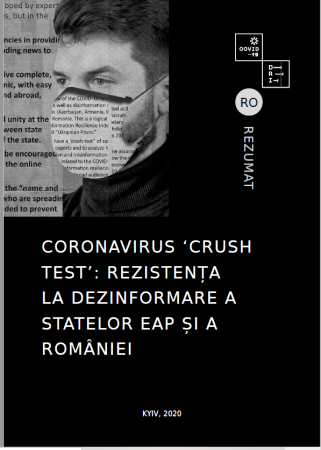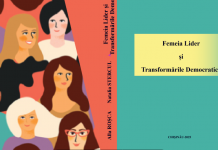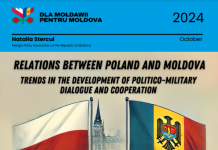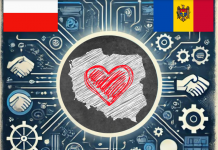Summary
The study presents an overview of the COVID-19 related actions and communication strategies, as well as disinformation narratives in the six Eastern Partnership states (Azerbaijan, Armenia, Belarus, Georgia, Moldova, and Ukraine) and Romania. This is a logical follow-up and topical addition to the Disinformation Resilience Index 2018, published by the Foreign Policy Council “Ukrainian Prism.”
The aim of this research is to have a “crash-test” of some assumptions made in 2018 by the national experts and to analyze how the states’ resilience towards disinformation and misinformation evolves. The rampant flood of disinformation related to the COVID-19 pandemic turns out to be a test for state disinformation resilience. In addition, the study aims at raising awareness of broad audiences about possible threats of disinformation activities related to COVID-19 and state resilience.
While countries are obviously focused on managing humanitarian and healthcare issues related to the coronavirus outbreak, the information sphere is also under strain. As far as our analysis suggests, while sources of disinformation can be different (both domestic and foreign), their consequences are similar and could generate panic, distrust in governmental activities, and crisis mishandling.
The logical framework of the analysis is structured around three main components: country chapters, disinformation narratives, and the Index. The local experts in seven countries analyzed the actions, statements, and initiatives of both governmental and non-governmental institutions, including media and religious organizations, as well as narratives presented in the public and media discourse within a period of 6 months (February-July 2020).
The analysis showed that even if in the majority of countries, the first cases of COVID-19 were detected in March, the disinformation and conspiracy theories had been spreading since January-February. Those disinformation narratives were part of the global tendency and had mainly a geopolitical nature linked with China-US discourse or fear of the unknown.
The research results established that introduction of a state of emergency almost did not have any impact on the spread of disinformation. One of the main factors that influenced disinformation flow was timely and sufficient, as well as the coordinated delivery of information by the appropriate governmental authorities. As soon as the media and public had open access to information, through regular briefings, official websites, etc., the information vacuum has been filled, leaving less space for gossips and manipulations.
Media played a serious role both in disinformation spread and debunking. Unfortunately, in some countries, media became a hostage of the political preferences of their owners, or, in the initial stage, of the lack of the specific knowledge necessary for covering pandemic stories. The situation was better in the countries with Code of Conduct and media self-regulation norms and concurrently was more challenging in those where media was predominantly controlled by a state.
All countries faced a problem of balancing between the necessity to prevent the spread of the disinformation, thus blocking some news or online resources circulating them, and a right for free speech and media activities. However, the level of governmental criticism was arguably correlated with a level of democracy in the respective countries and trust in governmental actions. For instance, in Azerbaijan and Belarus there have been numerous previous cases of misuse of power and use of blocking as a punishment for the opposition, so any new restrictions have been perceived through the lens of additional pressure. Whereas in Ukraine, the public accepted the necessity to block some Facebook pages by security services as a necessary step to prevent disinformation spread, as previously such actions have been predominantly connected with preventing Russian or separatist propaganda.
Romania, Ukraine, and Georgia ranked the highest in terms of resilience, society and governmental response, although still did not reach the top marks. Concurrently, Azerbaijan, Belarus, and Moldova scored the lowest. For government response, Georgia received the highest score (6 out of 9), followed by Ukraine (5 out of 9), while Moldova – the lowest (0). Media performance was the best in Romania (3 out of 4) and the worst in Belarus (1 out of 4). Civil society’s response was the most active in Ukraine and Romania (7 out of 8 for both countries) and the least active in Azerbaijan and Belarus (1 out of 8 for both countries).
Narratives
As the study indicated, while the Russian narratives are steadily occupying public discourse, during the pandemic, the Russian Federation was not the only source of disinformation, leaving enough space for global and domestic narratives generation. Still, the Russian speaking population remained the most vulnerable to disinformation.
Most of the disinformation narratives circulated during the pandemic and identified in all the studied countries could be grouped as follows:
• health related (e.g., symptoms, diagnosis, cures);
• geopolitically oriented (e.g., actions or influence of the third states, those related to foreign policy, foreign assistance);
• government related (e.g., threats to democracy and human rights, ‘failed’ governments, political cleavages, etc.);
• conspiracy theories (e.g., 5G network, virus as a purposefully created bioweapon, virus invented by Bill Gates, etc.).
Azerbaijan, Richard Giragosian, Regional Studies Center
In Azerbaijan, disinformation campaigns had roots both at the global and national levels, while the authorities have largely mishandled the situation. Information from state-run media and research centers in Russia has remained the main source of COVID-19 disinformation with a Russian-speaking community as the most vulnerable group in the country. Independent media and civil society were immensely restricted due to the general political situation in the country. Strict restrictive measures imposed by the government have been highly criticized, and did not have any positive effect on Azerbaijan society resilience to disinformation. Despite the fact that high-level authorities were providing facts and basic information, they have lacked openness for questions from media and civil society, thus creating an information vacuum. The initial confusion regarding the conduct of religious gatherings did not result in information misleading the society. Religious communities, including their leaders, were active neither in information discourse, nor in spreading disinformation. The main narratives were changing with the development of pandemic, starting from the geopolitical ones (reports about the United States creating COVID-19 as a biological weapon and the European Union falling apart) to those, during a peak of the pandemic, appraising the so-called ‘successes’ of the government in handling the pandemic, claiming that ‘Azerbaijani experience’ of measures and fight against coronavirus are studied by the world.
Armenia, Najmin Kamilsoy, Charles University
Armenia witnessed a serious range of anti-governmental narratives connected with the general political competition in the country when disinformation was mostly spread by political opponents to undermine trust in the Armenian government. The government’s initial response started with the appointment of Deputy Prime Minister as a central figure or a “point person,” as well as with systematic updates provided by the Ministry of Health. Regular briefings had a positive effect for filling information vacuum. However, the issues of pandemic mishandling and data privacy shadowed an initial positive response. High politicization of media landscape in Armenia had its negative effect. In terms of social media, what had a significant effect are (former) doctors – bloggers, who used to mix politics and medicine and spread disinformation about the virus. Civil society had both positive and negative responses and was involved in both spreading and debunking disinformation. The main narratives popular in Armenia have been those criticizing masks and quarantine measures, building distrust for the government, addressing George Soros’ role in virus spread.
Belarus, Dzianis Melyantsou,Minsk Dialogue Council on International Relations
Belarus case has its particularities, since it is the only country where quarantine and emergency state have not been introduced. In addition, the pandemic has been developing along with a very tense election campaign. Thus, the government and top officials themselves became one of the main sources of disinformation, together with the Russian information sources. At the first stage of pandemic spread, Minsk’s information policy was largely focused on preventing panic among the population by publishing very limited data about the epidemiological situation and downplaying the risk of infection. President Lukashenko became the main newsmaker of false information. This resulted in an information vacuum and gossips spread about the real situation around COVID-19. Independent media and opposition politicians criticized the governmental actions and tried to present alternative sources of information. This was used as a reason for attacks against the opposition media. In the situation of no quarantine in Belarus, civil society organizations and groups have been more involved in advocating stricter measures of social distancing and supporting medical personnel and hospitals than in debunking activities. The main narratives were about denying the COVID-19 danger, geopolitical competition between China and the US as a reason of crisis, and gossips about high mortalities in different towns.
Georgia, Lasha Tughushi, PhD, Liberal Academy Tbilisi
The governmental response in Georgia was one of the most successful, resulting both in the best pandemic situation and in good communication strategies. However, the political crisis and expected parliamentary elections during the pandemic had a negative impact on the information environment. The biggest challenge for Georgia was communicating quarantine measures and other restrictions to the national minorities (Azerbaijani and Armenian communities) that led to a number of incidents. Establishing the Interagency Coordination Council by the Government of Georgia had its positive effect, given that important information was provided, daily briefings organized, special websites and a hotline created. In terms of media, the problem with Russian media and with the one at the occupied territories of Georgia that retranslated Russian disinformation could be observed. Most of this disinformation was connected with the fake news about US laboratories in Georgia that allegedly ‘had created COVID-19′. Anti-US, anti-liberal, anti-quarantine narratives have been the most popular.
Moldova, Natalia Stercul, PhD, Foreign Policy Association of Moldova
In Moldova, the pandemic response and its coverage in the media have been highly politicized. The general political competition in the country had its negative effect and led to an increased level of misinformation and manipulation with information. Russian and Chinese disinformation campaigns and media influence have been noticed. Moldova’s Response Plan presented in March had a communication component that included media and social media, top officials briefings, hotlines, and websites. The communication about the COVID-19 situation in the country was conducted twice a day on behalf of the pandemic task force. However, the general low trust of the Moldovan population in their government and disconnection between the information provided and real facts on the ground led to the negative perception of the official information. In addition, the President and the Government provided contradicting information. In media, a significant presence of the Russian media content and Russian TV channels had a serious negative effect, which included both false news and propaganda. The church was one of the sources of disinformation, including spreading fakes about 5G and virus origin (most of the narratives were identical to those spread by the Russian Orthodox Church). The main narratives in Moldova were about methods of treatment, fears about impossibility to recover, as well as conspiracy theories (population chipping, 5G, US laboratories). In addition, a geopolitical discourse was present, mainly the one stating ‘the death came from the West, and help comes from Russia and China’.
Romania, Teodor Lucian Moga, PhD, Centre for European Studies, Faculty of Law, Alexandru Ioan Cuza University of Iasi
Faced with the prospect of the Covid-19 pandemic, the Romanian authorities managed to put together a patchwork of measures to prevent the spread of the virus and sought to inform the population about the increasing risk. Yet, the societal response was mixed, while the government’s response have had a puzzling effect on parts of the population. Against this background, the Romanian informational space has been hit by consecutive disinformation waves. Among the narratives, conspiracy theories have been the most popular in Romania, related to the origin of the virus and the malicious impact of the 5G network. One of the most visible sources of disinformation have been the websites originating in the Republic of Moldova. The research concluded that solely pointing at Russia for the current disinformation campaigns, which have hit Romania, would be too simplistic since domestic entities, with no clear links to the Russian Federation, might also be interested in distributing misinformation and alternative narratives for similar purposes: to weaken trust in institutions and sow panic.
Ukraine, Sergiy Gerasymchuk, Oleksanrd Kraiev, Foreign Policy Council “Ukrainian Prism”
Manipulated information, using a mix of emotionality and rationality, has become pervasive and dominant in Ukraine since 2014 and crystalized in the 2020 pandemic crisis. A relatively long experience of information war with Russia, as well as an existence of the number of debunking and information security NGOs, assured some sort of specific resilience of Ukrainians towards disinformation and fake news. The government response was satisfactory with daily information provided and special websites created. Security services were also involved in preventing disinformation spread, especially in social networks. Media appeared less resilient due to several factors: the politicization of the media landscape, lack of professional knowledge, Russian influence, and reference to unchecked unknown sources. At the same time, there were positive examples of media outlets creating special coverage to fill the information gaps and to debunk myths about COVID-19. Civil society in Ukraine became the most resilient and prepared, worked actively in all directions: providing adequate information, debunking myths, fact-checking, etc. Disinformation spread in Ukraine differed depending on the situation. It has started with fake news and conspiracy theories due to the lack of knowledge, in addition to geopolitical narratives about foreign support in fighting a pandemic. The most popular disinformation was about virus origin (including ‘US laboratories in Ukraine’) and methods of treatment, as well as George Soros’s role in causing pandemic.
Recommendations
The following recommendations have been developed by experts that can be applied not only in individual countries, but in the whole region.
- Effective coordination between ministries and agencies in providing information to avoid misunderstanding and misleading news to increase trust.
- Need to ensure at the state level that citizens receive complete, truthful, and timely information about the pandemic, with easy access to information both inside of the country and abroad, including the languages of national minorities.
- Mutual trust is essential for ensuring cohesion and unity at the societal level. Conversely, lower levels of trust between state institutions and civil society affect the resilience of the state.
- Professional fact-checking and debunking need to be encouraged in order to fight the disinformation, particularly in the online environment.
- In addition to debunking the disinformation itself, the “name and shame” method should be used to address those who are spreading disinformation. The appropriate measures are needed to prevent future cases of disinformation.
The research was carried out in Summer, 2020 by the Foreign Policy Council “Ukrainian Prism” (www.prismua.org) in the framework of the project “Coronavirus crush test: Disinformation Resilience of EaP states and Romania”, supported by the Black Sea Trust for Regional Cooperation, а Project of the German Marshall Fund of the United States. Opinions expressed in this publication do not necessarily represent those of the Black Sea Trust or its partners.
Download summary: http://www.ape.md/wp-content/uploads/2020/10/SummaryEN-2.pdf







